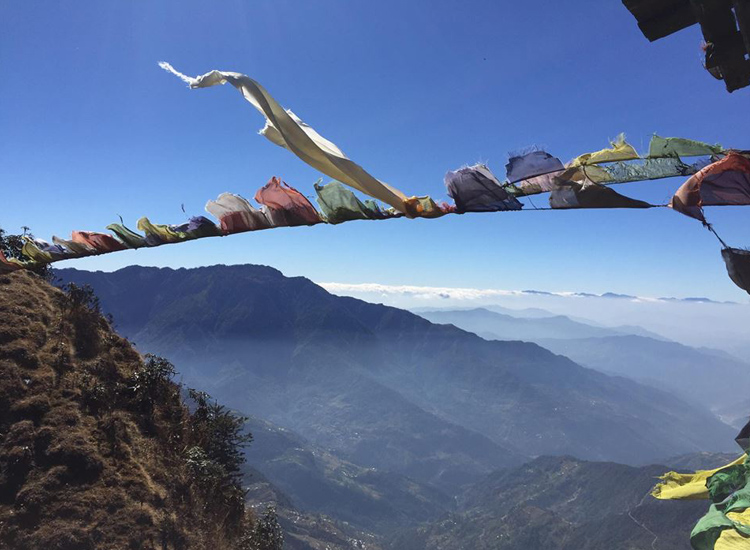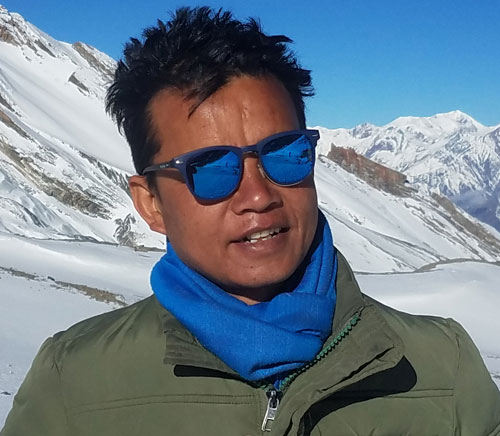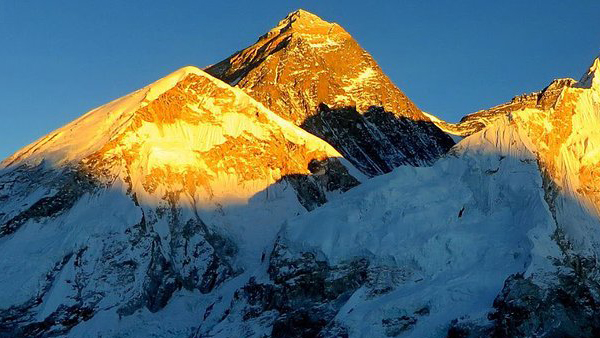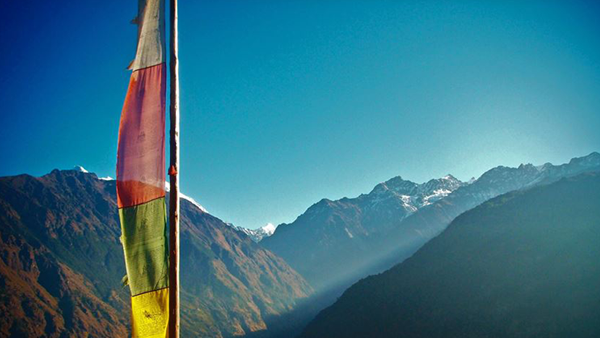
Bigu Gompa route is one of the unmissable for the trek. Gaurishanker floats in the sky like a brooding dragoness, watching hawkeyed every moment of those interlopers called trekkers. The route serves as an interesting add-on-to the Rolwaling Trek or the Lapche Valley Trek. The trek offer you diversity landscpes, diverse cultures , pictureque villages.
The route layout by Incredible Himalayan Sherpa Adventure will offer you great amount of enjoyment and unforgetable unique experince.
Highlights
- Standout villages and well-brought-up villagers along the trails
- The uttermost mesmerizing Bigu Gompa chanted by nuns.
- Chortens,Mani walls prayer flags and tuneful Buddhists song
- Whilst getting back cycling is incredibly hysterical
Itinerary
Day 01
Trek to Simigaon (2100m/6889.764 ft.),5-6hr drive+2hr walk
Day 02
Trek to Gonggar Khola (1250m/4101ft.),3-4hr walk
Day 03
Trek to Orang(1900m/6233.596 ft.), 6-7hr walk
Day 04
Trek to Laduk(2000m/6561.68 ft.), 3-4hr walk
Day 05
Trek to Bigu Gompa(2515m/8251.312 ft.), 4-5hr walk
Day 06
Trek to Tisang La(3320m/10892.39 ft.), 4-5hr walk
Day 07
Trek to Dolangsa (2320m/7611.549 ft.), 3-4hr walk
Day 08
Trek to Karthali (1500m/4921.2 ft.), 6-7hr walk
Day 09
Trek to Barhabise (819m/2687ft.) & scenic drive to KTM (1350m/4429 ft.), 4hr walk+5-6hr drive
Location
Our Offer
We offer 3 packages: Basic, comfort & Full Board. Our Basic takes care of your trek, comfort include trek with your stay in Kathmandu along with all airport transfers personally while Full Board include entire meals in the mountains during the trek. Three can be flexibly adjusted to your requirements.
Basic Offer
- Trek with an English speaking govt licensed trekking guide
- 1 porter (betn two clients) to carry your luggage during the trek (max 24 kg; i.e. 12kg pP)
- Accommodation during the trek in carefully selected teahouses as per the itinerary
- Sharing Vehicle from KTM - Barhabise and return
- Duffel bag and trekking map
- Trekkers Information Management System [TIMS] registration card
- Necessary paper works, all government, and local taxes
- Farewell dinner in Kathmandu by the host family at Typical Nepali Cultural Restaurant
- First aid medical kit, oxymeters to check pulse, heart rate & oxygen saturation carried by guide
Comfort Offer
As Basic and
- 2N in 3* and 1N in 4* hotel in KTM on B/B plan as per the itinerary [upgrade possible]
- Airport pick up & drop off personally
Full Board Offer
Price: Have a kindly make an enquiry for the Full Board tour cost. Because the cost depends on the meals chosen by you.
As Comfort and
- Full board meals in the mountains during the trek
Group Discount:
There is a further discount for larger groups. Please contacts us for details at mytrek2nepal@gmail.com
Trek Duration:
The Trek duration can be shorten or extend depending on time and fitness.
Excluded Services
- International Airfare to and from your country
- Nepal visa (USD 25 for 15 days and USD 40 for 30 days, two passport photographs required). For the further more information, have visit Nepal Immigration Department official website.
- Insurance - Following stated things must be submit while you do trips through (IHSA)
- You must submit copy of your insurance certificate included standard policies that covers trekking activities up to 5000m
- Your Insuarnce policy must cover accidents, medical expenses, and emergency evacuation including helicopter rescue upto 5000m and it is excluded in the trip price
- At the time of you do Insurance you should read the policy carefully whether your requirements are included or not
- IHSA also recommends your insurance policy covers cancellation, curtailment and loss of luggage and personal effects
- Any alcoholic beverages, cold drinks and boiled water as well as snacks, deserts etc. during the trek
- Tipping is a culture in Nepal and is expected by your staff (guides, porters, drivers)
- Hot shower, wifi, battery charges (available at extra cost in lodges, sometimes free)
- Unforeseen expenses not under our control such as flight cancellations or delays, weather-related issues, illness during the trek, rescue costs, etc
- Any other costs not specifically included. Please feel free to ask if in doubt
Equipment
Trekking Equipment
Have a kindly bring following stated equipment for the camping/tented trek. The equipment you can buy in Kathmandu with different quality in good price.
Luggage:
01 large duffel bag: The Luggage is for to carry all your personal gear on the trekking. Should be strong and durable. The best size would be around 30" x 14", with a full-length zipper and handles.
1 rucksack or day pack: The bag is for to accommodate a sweater, rain gear, water bottle, camera and accessories and any miscellaneous items you need to have during the day. We recommend a pack with at least 1450cu. In capacity, or smaller if you are not carrying a large amount of camera equipment.
Head and Face Gear:
1. Sunhat
2. A Bandana
3. Sunglasses
4. Warm hat
5. Sunscreen with a very high SPF factor
6. Lip balm with a high SPF factor
7. An emergency light
Hands:
1. Lightweight gloves
Inner Clothing:
1. T-shirts
2. Thermal underwear- Top and bottom. Synthetic is best
3. Underwear
4. 2 shorts
5. 2 Trousers- (comfortable) One thin, one thick and warm
Outer Clothing:
1. down Jacket
2. Fleece Jacket (or a windproof jacket)
3. Waterproof jacket with a hood (or a poncho)
4. Waterproof pants
5. Baggy pants
6. 2 pairs of gloves/mittens (1 thin and 1 thick)
7. 1 sweater to be worn under the fleece jacket
Footwear:
1. Light weight walking boots- (leather is recommended)
2. Spare laces
3. 2 pairs of thick woolen socks.
4. 2 pairs of thin socks to be worn under the woolen socks
5. One pair of sandals or comfortable shoes for camp
Drinking Equipment:
1. Water Bottle
Purification equipment-Boiled drinking water will be provided but further purification with iodine or purification tablets is highly recommended.
Sleeping and Carrying Equipment:
1. 30-40 liter daypack
2. Water Proof Bag-A water proof bag to cover the rucksack
3. Sleeping Bag- Please brings a bag that can resist temperatures as low as -15 degrees Celsius
Personal Medical Kit:
1. Bandage for sprains
2. Plasters/Band-aids
3. Iodine or water filters
4. Moleskin/Second skin - for blisters
5. Antiseptic ointment for cuts
6. Anti-bacterial throat lozenges (with antiseptic)
7. Aspirin/paracetamol - general painkiller
8. Oral rehydration salts
9. Broad-spectrum antibiotic (norfloxacin or ciprofloxin)
10. Anti-diarrhea medication (antibiotic)
11. Diarrhea stopper (Imodium - optional)
12. Diamox (altitude sickness - can be bought in Kathmandu)
13. Sterile Syringe set (anti-AIDS precaution)
Extras/Luxuries:
1. Binoculars
2. Reading book
3. Trail Map/Guide book
4. Journal & Pens
5. Travel game i.e. chess, backgammon, scrabble
Toiletries:
1. 1 medium sized quick drying towel
2. Toothbrush/paste (preferably biodegradable)
3. Multipurpose soap (preferably biodegradable)
4. Deodorant
5. Nail clippers
6. Face and body moisturize
7. Feminine hygiene products
8. Small mirror
Information
Additional Options:
+Additional porter:
We plan with one porter per 2 clients. If you require additional support, you can book an additional porter for the trip to lighten your load. A porter carries your bag pack for you and no more (20kg max. They don't often speak any English. They carry two backpacks that they will strap together. But you are strictly prohibited not take advantage of the porter. They are usually very proud people and will attempt to carry things that are just too heavy. Which is not good. You can leave your unnecessary stuff in Kathmandu your hotel or our office you will not need on the trek.
Have a take a small personal daypack with you. Your daypack should contain everything you need during the day but keep it as light as possible. Examples: water, some warm clothing, your camera, sunscreen, etc. Note that luggage you hand the porters might not be available to you during the day as they sometimes set their own pace.
+ Hotel upgrade in ktm:[€60 for 5* hotel Per night]
If you feel like a little luxury before and after your trek, you can upgrade your hotel in Kathmandu to 5* category.
Nepal Visas
You need a visa for Nepal, which can be obtained in advance or on entry. If you wish to apply before departure the current visa cost is £20 for a 15-day visa and £35 for a 30-day visa for UK passport holders. The current cost of a visa on arrival is US$25 for 15 days, US$40 for 30 days or if extending your stay $100 for 90 days. All are multiple entries. The visa on arrival fee can be paid for in cash in US Dollars, Pounds Sterling or Euros. You will also need a passport photo. Application forms are available in the immigration hall (or for electronic passports, there are visa registration machines which, after inserting your passport, automatically fill out a form for you). You must firstly join the queue to pay the visa fee and then go to the relevant immigration desk to obtain your 15, 30 or 90-day visa stamp. There can be long queues for visas on arrival.
Flexible Timing
The flight from Kathmandu to Lukla significantly reduces the journey time compared to the trek via Jiri (which we also offer). The flight is the shortest and most popular way of gaining access to the region but the mountain weather is notoriously unpredictable and sometimes even during the best part of the season, flights are delayed or postponed for one or more days. We can also arrange for a Heli charter from Kathmandu to Lukla instead but this adds significant extra cost. We highly recommend that you take potential delays into account and allow for a week extra day in Kathmandu.
Money and Gratuity
Money and Gratuity; It is best to bring a mixture of cash and traveler’s checks in a major currency [some currencies are not convertible to NPR]. USD, GBP, CAD, EUR, and AUD are generally fine. Ensure you have also small denominations. As a guideline for baseline spending money we suggest USD 8 - 10 per meal in Kathmandu / Pokhara and USD 30 – 35 per day whilst trekking in the Annapurna region (if you drink or smoke or plan some major shopping this could be higher). You should exchange enough money into Nepalese Rupees to last the entire time of your trek BEFORE leaving Kathmandu. There are no exchange facilities in the villages along the trail but plenty of money changers in KTM.
Gratuity is, Since the 1960s when trekking in Nepal was developed, there has been a tradition for groups and independent visitors to gratude their crews at the end of a trek but gratuity are not included in the trip price. If you are happy with the performance of the trekking staff, we suggest the following as a minimum: USD 7 per day of the wages or around one day’s wage for each week on a trek. As a rule, and through tradition, the head cook should get a little more than the porters and ‘Sherpa’ and kitchen crews. The Sardar and Leader/Guide should get a little more again.
Drinking Water
Staying hydrated is important when undertaking any physical activity but particularly so at altitude where it is generally recommended to drink at least 3-4 litres per person per day.
We strongly encourage you not to buy bottled water on trek as this contributes to the growing problem of plastic pollution in Nepal’s trekking areas.
All tea houses will provide cold water free of charge, if requested. Although this should not be drunk untreated, we recommend that you bring a reusable bottle with a wide opening (Nalgene or similar) with you and use a SteriPEN to treat it with. A SteriPEN is a handheld UV water purifier – small, lightweight and battery powered so easy to pack for a trek. In Nepal’s trekking regions most of the bottled water isn’t strictly ‘mineral water’ anyway but is UV treated, so it’s exactly the same technology. It’s quick to use, far more effective than purification tablets, and the water is ready immediately. It’s fine to use a SteriPEN on non-boiled water so long as it isn’t cloudy or full of sediment (which is uncommon in these regions).
SteriPENs are widely stocked on Amazon, outdoor shops and other online retailers; look for the latest models but avoid USB charging ones. Better still, a SteriPEN will pay for itself over the course of the trek and you won’t leave behind a single plastic bottle – you will end up spending the same or even less than you would on bottled water, plus you can keep it for future trips.
If you prefer not to invest in a SteriPEN, the tea houses also sell boiled water for approx. Rs150-300 per litre (the price increases the higher you trek) which should not require treating. This is also perfect for a bedtime refill as it can double up as a hot water bottle.
While camping boiled water is supplied for drinking.
Weather
The main trekking season in Nepal is from October to mid-May when daytime temperatures at most altitudes are generally comfortable for walking, the sky is clear much of the time and rain and snow are occasional occurrences. Daytime temperatures will vary from 15ºC to 35ºC in the Kathmandu Valley to around 10ºC at 3,600m and progressively lower the higher we go.
Different seasons offer different advantages for trekking.
Post Monsoon/autumn: Mid-September to November. This is the main trekking season in Nepal. Day temperatures in Kathmandu are approximately above 20ºC. Skies are usually clear and days on trek are sunny and mild with clear mountain views. At the highest altitudes although the days can be nice and sunny the temperatures can drop to 10ºC and much lower. Nights will be colder with temperatures dropping as low as minus 10ºC and lower at the highest altitudes.
Pre-monsoon/spring: March to May. Both day and night temperatures will be warmer in general but haze will often build up in the afternoons. It is very hot in the lowlands and temperatures rise to 35ºC in Kathmandu. Flowers bloom in this season and this is one of the reasons people chose to trek in spring.
Snow can be expected on any departure, usually at the higher altitudes. Summit day will be a very early start (usually about 2am) and will be extremely cold. Although mostly it is calm and clear on summit day the mountain does occasionally get high winds. You need to be equipped for temperatures as low as minus 25ºC plus wind chill on summit day.
Please remember that in any mountain area the weather is never wholly predictable and you should be prepared and equipped to deal with any differences in weather beyond the conditions described above.
FAQs
Preparation
Reservation
Weather
Duration
Season
Region
Grade
Altitude
Walking
Accommodation
Trip Type
Transportation

Certificate of Excellence
Based of services & reviewTrek Map
Need More help ?
Talk to our travel experts by phone, email, WhatsApp/Viber, WeChat! We love to talk travel ! We're here to help and happy to assist you with your booking and make your dream come true.

Mr. Tsering D. Sherpa
(National Mountain Leader)
Mountaineering, Treks & Tours
- +977-9862258888
(WhatsApp,Viber)7/24 - mytrek2@gmail.com
info@himalayansherpaadventure.com



